

Jules Burt interview
By Ross Sillifant
(2016)
Best known for co-founding Digital Magic Software with Jon Law, Jules Burt got his start in the industry working on games for the Commodore Amiga, first at H&H Software and then at CRL. He ended his career working on the Sega Genesis/Mega Drive.
Q:
Can you talk about how you got started as a video game designer?
Jules Burt:
I got into games and programming when I was living in Saudi
Arabia as a teenager (with my parents!) and discovered the Sinclair Spectrum at
age 13, which I started with. I mainly started by copying in many programs
and games from magazines, and due to errors in inputting (and sometimes in
print), I had to learn how to debug code early on. Sometimes of course, you were
really typing in a lot of hex/data which was actually Assembly language and
content wrapped in a BASIC program, so it got more interesting. I used to
copy games (tapes) that I’d bought while visiting the UK for friends in Saudi -
but ultimately copy protection arrived, which spurred me on to hack away and
write code to get past these early copy protection systems to enable me to bit
copy the taped content. I finally also got a Sinclair QL which, although
seemed a little ‘stuffy’, it was my introduction to the 68008 chip.
I forgot to mention the best part about my love and involvement with the 68000.
When I was a lot younger, I had some brief experience with another computer,
around age 9-11. We were living in Sharjah (next to Dubai), where my dad
was working at the new International Airport. He was working on all the
airport display systems that show arrival/departure times on those big
boards and monitors around the airport. They were all controlled by a
computer in a room under the airport where he worked, and I learned to do some
simple coding on it, although without much purpose, so just text
manipulation, etc. The way we wrote code was to input instructions one by
one into a tele-typewriter, which then spat out a long paper tape with holes
punched in it. You would then take the tape and feed it into the side of
this huge computer that filled half the room, where it would then spit out a
new tape, which was the output and result. Then you’d feed that tape back
through the tele-typewriter and you could read the results (if your code had
even worked). My dad let me keep these huge manuals which had the
instruction set in them when we left Sharjah, and I kept them for many years.
Later when I started coding the Sinclair QL and the Amiga, I realized it was all
very similar, because the PDP-11 that was installed at the airport was
essentially the source for the 68000 chip! Fancy that. I already had
exposure to the 68000 assembly language when I was a lot younger! What a
cool, fascinating world that unfolds for each of us.
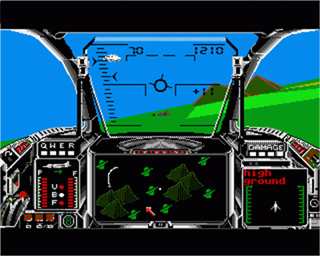 I
left Saudi at age 16 and went to 6th form college in the UK studying computer
science and advanced mathematics. During this time, I convinced my parents
that I needed the Commodore Amiga! I couldn’t believe such a machine
existed. It seemed so powerful with the bouncing ball demo. Later, I
discovered and was dismayed to find the spinning ball was just a 3-D illusion,
and began to realize what it meant to write cool stuff. Near the end of
two years of study, my computer science teacher suggested I get in touch with a
friend of his who was writing games. I met him and got offered a job on
the spot, working in a bedroom in his house - it felt like I’d finally ‘made it’
in life! He hired me to help convert Strike Force Harrier from
Atari ST to the Amiga, which I was now getting used to programming. I
remember the first day on the job, though, and had been asked to animate this
small section of the cockpit display, but honestly had no real idea what to do.
But my boss was very cool and helped me on day two, explaining what was needed
step by step, to where I felt way more comfortable and then got on with the job
from there. I learnt an incredible amount from him.
I
left Saudi at age 16 and went to 6th form college in the UK studying computer
science and advanced mathematics. During this time, I convinced my parents
that I needed the Commodore Amiga! I couldn’t believe such a machine
existed. It seemed so powerful with the bouncing ball demo. Later, I
discovered and was dismayed to find the spinning ball was just a 3-D illusion,
and began to realize what it meant to write cool stuff. Near the end of
two years of study, my computer science teacher suggested I get in touch with a
friend of his who was writing games. I met him and got offered a job on
the spot, working in a bedroom in his house - it felt like I’d finally ‘made it’
in life! He hired me to help convert Strike Force Harrier from
Atari ST to the Amiga, which I was now getting used to programming. I
remember the first day on the job, though, and had been asked to animate this
small section of the cockpit display, but honestly had no real idea what to do.
But my boss was very cool and helped me on day two, explaining what was needed
step by step, to where I felt way more comfortable and then got on with the job
from there. I learnt an incredible amount from him.
After working there for about 6 months, I finally got offered a ‘real job’
working in a company that had a studio - CRL Ltd. They had been having
success with some great, original games for the Spectrum like Tau Ceti, which I
helped with some aspects of porting to the Commodore Amiga. I worked for
CRL for about 1 year, where we worked round the clock, sleeping on couches,
and getting woken up by the office manager after only getting a few hours sleep each
night. CRL used to provide us with free cigarettes and Pro-plus tablets
(caffeine) to keep us working. Now I knew I’d finally ‘made it’ - this was
a real company! Myself and another artist (Jon Law) built an entire
game in just 5 weeks for the Amiga - Black Shadow, a vertical scrolling
shoot-em-up. Jon did all the graphics in just 2 weeks and then helped with
the design and with keeping me awake through the days and nights. During that
game, I finally and completely figured out how to take over the Amiga OS (and
turn it off) and started writing direct to hardware routines to finally
master the machine. CRL was a great thing and fun too, but I realized
quite quickly they were not concerned with people, just with churning out games for
a crazy lucrative deal they’d secured with EA to distribute a lot of games,
while we got pop and cigs and hassle from the office manager each time we needed
sleep!!?
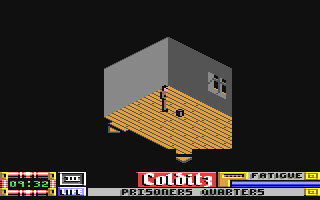
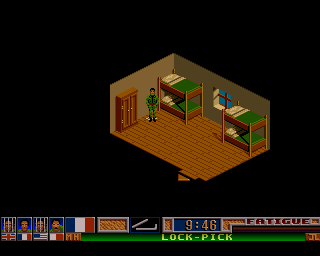
Escape from Colditz for the C-64 (LEFT) and Amiga (RIGHT)
Myself and Jon decided we were going to start our own company, and ultimately
left to start Digital Magic Software (DMS) around 1989 and moved up to Widnes, near
Liverpool. When we left, another programmer and artist joined us, and we
bought a big, terraced house to work and live out of. Now we were buying
our own cigarettes and pro-plus! We had great fun for the first 2 years,
making a number of games for the Amiga: Trained Assassin, Scorpion,
Drivin’ Force, Shockwave, and Escape from Colditz. In
addition to programming, I was also CEO and operations manager - getting all the
boxes manufactured and manuals printed, and when we had tested our games enough,
I drove to the disk duplicators and worked round the clock to format the disks
for duplication. We packed the first few thousand boxes in the
house/studio, and I remember how all our rooms filled up with packaging, etc.
I also drove round the country meeting distributors, magazines and some
retailers. In those days, everyone was very supportive (the reviews were
great) and life seemed good. Sadly, my business acumen was lacking, and I
wasn’t aware of margins and other such important details, so we started to
struggle and couldn’t quite make enough profits to make life easy. We
really wanted to maximize our efforts, so we had started to attempt to produce Atari
conversions of our games, but that machine couldn’t quite do what we needed (for
games like Shockwave and Drivin’ Force) and reviews were bad (justifiably).
We also finally attempted a C-64 version of Escape from Colditz. Sadly, we
were spreading ourselves thin, and I was having a challenge programming and
running the business at the same time. Finally, the Nintendo and Sega
machines/market had arrived, and the costs to manufacture were too prohibitive;
we simply weren’t selling enough games to survive. The last year was very
stressful. We lost the additional 2 guys that started with us, but did hire a
few more people during that last year. We were ultimately forced by our
suppliers to close the business as revenues weren’t sustaining us and paying the
bills. I remember my parents had invested a lot of money in addition to
suppliers extending us credit, so was a very difficult time for me, particularly.
That was about 1992. Some highlights for me were the magazines, Amiga
Computing for example, and the support we got - some great hacker/demo
writers and music creators we got to know from Europe (who’s names I sadly don’t
recall) who helped with our tunes and code to play multi-channel stuff, and
informed us when hacked versions of our games were available (which was about 3
days after we shipped, most times). Also, I remember when Jez Sans
rang us up to order a copy of Drivin’ Force (which we got to show it on Saturday
morning TV) and quizzed me, asking if it really ran at 50 fps, which it did!
I remember processing his VISA card that day, and we all celebrated!
Through the years, my partner Jon was a rock. His graphics for most of our
games were awesome, and his game design was what got our games built, quite
honestly.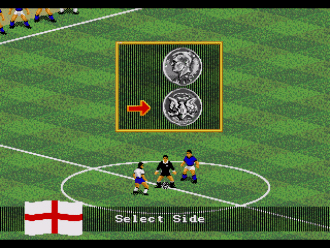
After DMS, Jon and myself were somehow fortunate to get sent a Sega Genesis
development kit from a very kind German man (who I don’t recall the name of,
either) but it was what got us off the dole, really. We had built a couple
of cool demos - one a top-down driving rally game, and another driving around NY
city (Jon had accurately constructed the entire city). We got contracted by
a company in France called Titus to write Prehistorik, a side-scrolling
caveman basher, but never got paid, sadly. Finally and fortunately, we were
approached and contracted by EA to develop the first running prototype of
EASN Soccer, which became EA Sports FIFA International Soccer after they got
sued by ESPN. We were ultimately hired full-time by EA UK where we went on
to develop the unreleased Aspect Warriors (Sega Genesis) and then EA
Sports Rugby.
Throughout all these years, there was a thread for me which was the 68000 chip
and its Assembly language - it was all rather cool. We didn’t realize that
we were making games that many, many people thoroughly enjoyed, as we were
really building them for ourselves on some level. Shame I wasn’t a
scrupulous businessman to make them more successful, but I guess that wasn’t my
path in life.
Q: I'm very interested to hear in your own words, about your role(s) on various Digital Magic Software Games on the Amiga (and announced for the Atari ST).
Jules Burt: Digital Magic games were all running at 50fps. We made this choice to ensure the slick, smooth-scrolling, and animation, and really helped us stand out against the pack. It was a key moniker in our ads - ’50 frames per second’. Of course, this limited us on some level also, where other games from the Bitmap Brothers were IMO more detailed and went further visually, but they ran at a sluggish 25fps and sometimes dropped to 17fps.
Q: Can you tell us a bit more about Trained Assassin, Scorpion, Drivin' Force, and Shockwave?
Jules Burt:
Trained Assassin was written by myself. A young guy called
Jarred did all the graphics and it was really awesome. It was a
slightly tough game to play, but was also unique with the changing, scrolling
direction of each level, which had an added challenge, as you couldn’t shoot up
and down! I remember testing and fixing many, many bugs as we finalized
it. Game quality and attention to detail as we polished them off was very
important to us.
A lot of our inspiration came from arcade games. Trained Assassin was
loosely based on R-Type. Scorpion, well I’m not sure, Jon developed
the visuals and gameplay, and as far as I remember, it was really his original,
cool concept.
Yes of course Driving Force
was inspired by Power Drift, and Afterburner inspired Shockwave.
Shockwave, though, had a great balance of a strategy component, which really was
a key part of the gameplay and mechanic; it wasn’t just an arcade shooter.
Shockwave was also written by a contracted programmer called Lance Abson.
He took some of the Drivin’ Force code and adapted it to allow the tilting
horizon. There was also a great Star Wars-like trench sequence you
had to navigate through.
Overall the press was very supportive. Most of our reviews were
8-9/10-ish. As I’d mentioned, the Atari ST version of Drivin’ Force never
came close, and without the 50fps, it lost the arcade-like visual quality. Our
inability to generate Atari versions of all our games was merely due to human
bandwidth. We felt it better to generate new products rather than spend
time converting, particularly to a machine that had far lesser graphic prowess.
Q: What can you tell us about the announced Atari ST versions of your games? UK Press seemed sure they were on the way.
Jules Burt:
Yes, I saw some of the reviews making claims about ST versions of
Scorpion etc. Maybe my memory fails me, but I really don’t believe we had
stated we intended to move all our titles to the ST. Even the mention of a
PC version seems dubious in one case. The only U.S. (Canadian in fact)
company we talked to was called Gold Disk, and they were talking about
publishing in the U.S. but not for the PC. Again though, they never delivered on
their promise, and we spent too much time haggling with them over a few thousand
pounds (for the entire deal). I honestly think Drivin’ Force was the only
one we did consciously as it was our best seller to date. Sadly ,the ST
couldn’t compete.
Atari didn’t approach the studio, and we never made any moves in that regard.
I think had they, we would likely have looked at it. I don’t know today
what chips they ran on, so not sure what effort it would’ve taken. I was
personally interested in a novel OS called Taos, running on the ST I
think, which seemed to do miraculous things like ray tracing and superb
graphical feats. We did also speak to some companies like Activision back
then about using Drivin’ Force as a basis for Power Drift, and Rod Cousens
(sp) seemed very interested at the time, but ultimately told us they were
developing it themselves.
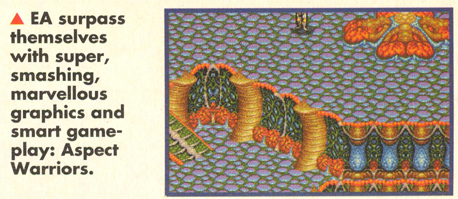 Q:
Jules, what can you tell us about the very promising looking Sega Mega Drive
title, Aspect Warriors?
Q:
Jules, what can you tell us about the very promising looking Sega Mega Drive
title, Aspect Warriors?
Jules Burt: Aspect Warriors was the first title we were tasked with building when we were hired into EA UK full time (after doing the FIFA prototype). The project was run by another Producer (Steve Wetherill) who was really into Games Workshop stuff, as was Jon (and still is, too). Aspect Warriors was one game world which was licensed by EA, so that was our source material.
Q: My understanding, thanks to the Mean Machines preview of Aspect Warriors, is that it's an unreleased isometric action/RTS, based on a license from Games Workshop. Started in January 1993 and due for release in February 1994, it was said to be EA's first in-house Mega Drive game to be fully developed in the UK.
Jules Burt: Sounds about right.
Q: Basically it looked and sounded (concept-wise) bloody marvelous (LINK), so what on Earth became of it, and does any code still exist?
Jules Burt: Really, the whole engine was written from scratch and was a design rip-off of Desert Strike - a game we were all playing and testing at the office. The mechanics of these ‘missions’ and the slight strategy required to complete each mission was worked into Aspect Warriors, albeit with a ground-based character. This allowed more interesting varied height terrain options, and we really felt we went beyond with the visuals, with explosions and smoke that remained as you destroyed targets and characters, etc. The team was almost at Alpha, and we were tuning and polishing and yes perhaps still building a little, but one day we were all called into a meeting room. EA execs told us the game was being cancelled despite it being so close. We were also told that an additional 20 other Sega games that EA was developing had also been cancelled that same day, so we didn’t feel that bad. But of course we were bruised and sad, but we’d been paid for all the work done (which made a change) and so when they re-tasked us to make EA Sports Rugby, we just shifted gears and went full onto that, instead. If there’s any lost code or cartridge images, they would be in EA's vaults.
Q: Are there any other lost games (any format) that you can shed light on?
Jules Burt: You’d mentioned the C-64 version of the Amiga Escape from Colditz - another quite successful game for DMS. The article I read which you sent wasn’t entirely true, about who worked on what. We really did want to build the C-64 version. We’d done some tests and realized we could recreate the disappearing walls, and really the game, overall. Steven "Ste" Pattullo, the original programmer we’d hired, had honestly struggled to get very far, and sadly I had to let him go at one point (my first firing). I remember that day, and how relieved he was that the pressure was off him, as he’d been struggling. Miles Barry joined the project and had written a bunch of impressive sound and visual demos. We really thought he was going to carry it through, but I remember I had to start learning to code 6502 to really get the game working fundamentally. It relied on perfect multi-dimensional scrolling with layers that could be turned on and off. I was quite sad that we didn’t finish this game ultimately as it was looking cool, and although Miles worked on it, he couldn’t seem to take it to completion. Demo writers have a very different (and cool) skill set - sometimes making my jaw drop. I often encouraged these programmers to write games, but they were into something different. Miles, however, was a great laugh. He brought a new, fresh dynamic to the company, but also sadly had joined us during that last challenging year before we closed shop, and so the C-64 version died.

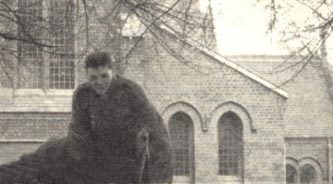
From left to right – Mike Halsall (Amiga), Ste Pattullo, Jon
Law, Mike Steffens (Rep), and Ste Pattullo again.
The shots included in the C-64 article (LINK) were interesting, particularly the b&w ‘German’ shots of us lot. I spotted another programmer that work for us who was a whiz - Mike Halsall. He was the Amiga programmer of Escape from Colditz. He was also instrumental in helping us create an Amiga to Amiga development kit we had, which meant we could compile and then run on a connected machine, allowing pretty good live debugging through a wire. How Mike accomplished this and hacked the existing debugger to work down a cable, I have no idea. I remember his code was hidden in the ‘about menu’ of the debugger, so he was a sneaky guy, but he got amazing, clever things done at DMS. He loved Queen (which I’d never heard of) and looked quite a lot like Freddy Mercury, too. The story about making the characters female akin to the TV show Prisoner: Cell Block H probably was some late night hack we did; we sure were watching that show through the long days and nights. I remember Queen B was the main prisoner that no-one argued with!
The last front cover of Drivin Force
was interesting. We had ordered The flag from a racetrack in the UK. The
gloves and helmet were lent to us by a local bike shop, and he let us take them
away without even asking for a deposit; we explained why we wanted to borrow
them, but remember, this was Widnes/Liverpool. Needless to say, we returned
them to him, and the keys. Well, they were my house/car keys out my pocket.
Those were the good, old days of self-publishing, a bit like the ‘German' shots of
us for Colditz. We rented some uniforms from a costume shop and took the pick at
an old church in Widnes!
| GAME | SYSTEM | COMPANY | STATUS |
| Strike Force Harrier | Amiga | H&H Software | released |
| Tau Ceti | Amiga | CRL | released |
| Black Shadow | Amiga | CRL | released |
| Trained Assassin | Amiga | Digital Magic Software, Ltd. | released |
| Drivin’ Force | Amiga, ST | Digital Magic Software, Ltd. | released |
| Shockwave | Amiga | Digital Magic Software, Ltd. | released |
| Shockwave | ST | Digital Magic Software, Ltd. | unreleased |
| Escape from Colditz | Amiga | Digital Magic Software, Ltd. | released |
| Escape from Colditz | C-64 | Digital Magic Software, Ltd | not completed |
| Prehistorik | Genesis | Titus | released |
| EA Sports FIFA International Soccer | Genesis | EA | released |
| EA Sports Rugby | Genesis | EA | released |
| Aspect Warriors | Genesis | EA | unreleased |